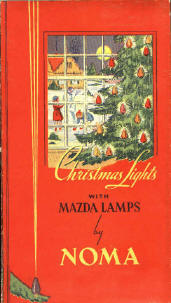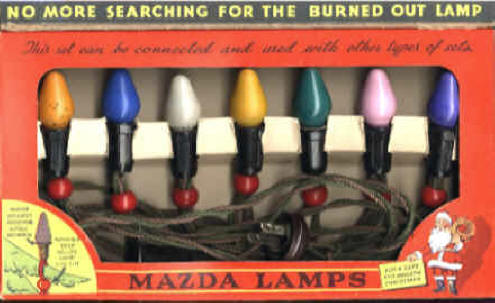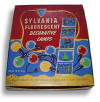|
Pictured above are some comparisons between
wartime packaging and Depression-era packaging. The boxes on the top row
are from the Thirties, while their counterparts pictured on the second row
are wartime boxes. Manufacturers had many more lighting strings in
inventory than they did boxes, and when it came time to print more
containers, the colors were much less vivid to save precious supplies.
Also, the collector will notice that wartime era boxes are of much thinner
construction than those from the Depression era.


An exception to the lackluster packaging was this set from
the NOMA Company. Because they were the largest Christmas lighting
manufacturer in the world, NOMA had a good stock of both boxes and
lighting strings, and were able to supply lighting outfits like the one
pictured above through about 1943.
Here are some other outfits that were sold both in the
Thirties and up through 1942:
As mentioned before, NOMA was able to
manufacture a line of wooden toys during the war years. Surprisingly, the
company also manufactured bombs and fireworks under their newly-formed
Triumph Industries division. It is ironic to note that NOMA-made bombs
were used in the war to heavily damage many Japanese factories, figural
Christmas light factories included. Those same factories would later
rebuild, and their products, imported quite cheaply in the 1950s and 60s,
were to become one of the major factors in the eventual bankruptcy of NOMA
Lites, Incorporated.
During the war years, NOMA president Henri
Sadacca had been buying up different companies, running them all under the
NOMA Electric Corporation umbrella. Some of these companies included the
Ansonia Electrical Company (electric wire and cable), the previously
mentioned Triumph Industries (bombs, munitions and fireworks), the Estate
Stove Company (electric and gas ranges for the military and later for
consumer use), the Refrigeration Corporation of America (commercial and
later, home freezers), Effanbee Incorporated (among their products was
Noma, the talking doll), and the Ward Heater Company (military and later,
home heating equipment). Other major lighting companies diversified as
well, including Paramount (Raylite) and Royal Electric. All of the major
companies survived the war, and the smaller companies that didn't were
snapped up by the likes of NOMA and Paramount.
By 1943, there were no Christmas lighting
strings or light bulbs to be had. NOMA ads pushing their Woodies line of
toys carried the message that "With Peace, NOMA Christmas Lights Would Be
Back."
On September 2, 1945, Japanese Foreign Minister
Mamoru Shigemitsu signed the instrument of surrender aboard the battleship
U.S.S. Missouri in Tokyo Bay, Japan, officially ending World war II. With
just three months until Christmas, none of the lighting companies could
gear up for the season, and it would take two more years until all of the
demand for Christmas light outfits and bulbs could be satisfied.
One notable exception was Sylvania, who, in
1945, managed
to introduce their totally new fluorescent Christmas lighting outfit,
which was quite a novelty. The price was a big concern, as the set sold
for more than four times what an average lighting outfit did, but since it was
one of the few sets available for sale in that year, it did
surprisingly well for a couple of years. However, the expense,
coupled with the fact that the lamps were not nearly as bright as
conventional Christmas lights, brought about their downfall in 1948 or
1949.
 |
 |
 |
 |
|
1945 Sylvania Fluorescent Lighting Outfit, outside |
End of Box |
Inside, showing the lamps operating. They are pure white when turned
off. |
1945 Sylvania magazine ad, introducing the new lights |
Sylvania only marketed their lamps under
their company name for the first year. In addition, Sylvania sold their
lamps to other companies who marketed them under their own names. Below
are two examples, both from 1945, from Royal and Miller.
 |
 |
 |
 |
Royal outfit, the set most
commonly found by collectors. |
Inside view of outfit. The plug on the lighting string is a
replacement. |
Fluorescent set from Miller Electric. This outfit is much less
common. |
Inside view of set from
Miller Electric |
End of Chapter
HOME
BACK
TABLE OF CONTENTS
|
































